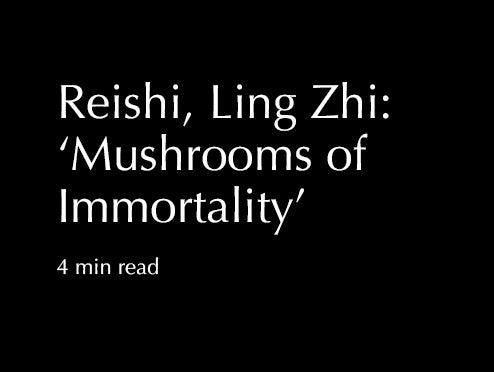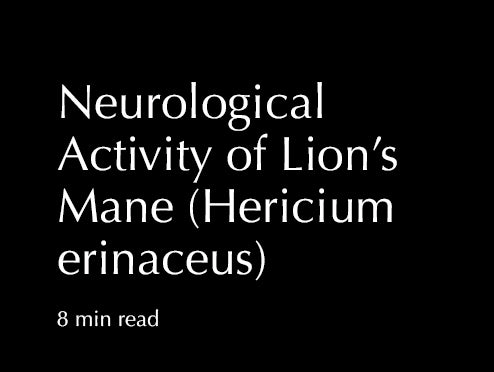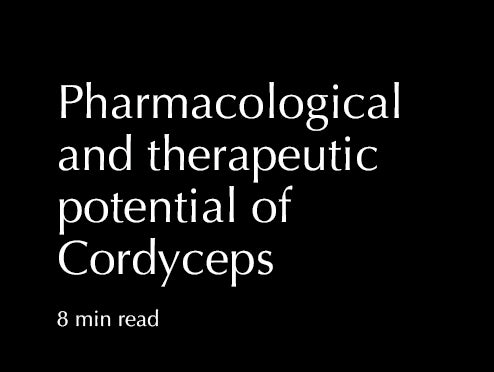Your Cart is Empty
| YOUR CART IS EMPTY Nothing to see here. But so mush room! Not sure where to begin? Most start here:  |
FREE SHIPPING ON DOMESTIC ORDERS OVER $40
FREE SHIPPING ON DOMESTIC ORDERS OVER $40

| YOUR CART IS EMPTY Nothing to see here. But so mush room! Not sure where to begin? Most start here:  |
October 02, 2019 6 min read
Reishi has been called the "panacea polypore," in part due to a widespread popular belief that this mushroom can help alleviate certain age-related diseases. Although many such claims are exaggerated and unsubstantiated, a number of studies have documented a range of medicinal effects.
In 2000, a group of Merck pharmaceutical scientists at the Centro de Investigaci´on B´asica, Merck Sharp & Dohme in Madrid, Spain tested the mycelial extracts of 204 species of mushrooms for their antimicrobial properties (Suay et al., 2000). The mushrooms showing the most activity were "reishi" species (G. lucidum, G. resinaceum and G. pfeifferi) of which 73 percent of the strains showed activities against the bacterium Bacillus subtilis. However, while extracts of the reishi species group all strongly inhibited Bacillus bacteria, they were curiously inactive against other disease-causing bacteria and fungi. That these Ganodermas are species specific in their antimicrobial activities suggests a unique mode of activity, a benchmark test that attracts medical researchers interested in new antibiotic drug discovery.
In my work with the U.S. Defense Department's BioShield BioDefense program, ethanol and water extracts of the living mycelium of Ganoderma resinaceum inhibited virus replication as measured by the viral yield reduction (VYR) assay of Flu A (H5N1) aka "bird flu," and Flu B viruses. Notably, a "traditional" hot water extract of the fruitbodies arising from the same mycelium demonstrated no notable antiviral activity (Stamets, 2008).
A review of the scientific literature reveals that many of the traditional medicinal claims can now be validated, especially the antioxidant and anti-inflammatory properties. However, the anti-cancer claims have yet to achieve the credibility of comparable studies on Turkey Tail (Trametes versicolor) mushrooms (see Turkey Tail post). In a recent critique of reishi studies published through 2012, the authors concluded:
Our review did not find sufficient evidence to justify the use of G. lucidum as a first-line treatment for cancer. It remains uncertain whether G. lucidum helps prolong long-term cancer survival. However, G. lucidum could be administered as an alternative adjunct to conventional treatment in consideration of its potential of enhancing tumor response and stimulating host immunity. (Jin et al. 2012)
While such conclusions presume similar sample preparations and consistent taxonomic identification from study to study, one common theme emerges. The species in the taxonomic constellation of "reishi" mushrooms consistently activate, in vitro and in vivo, human immune cells: macrophages, NK and cytotoxic T cells, on a dose-dependent basis. Moreover, in the previously-mentioned comparison of peer-reviewed studies on reishi and cancer, the authors conclude that the adjunct use of reishi may augment chemotherapeutic drugs to treat cancer and may extend their effectiveness. This is particularly important since a common concern among oncologists is that the antioxidant properties of medicinal mushrooms may interfere with chemotherapeutic drugs. Addressing this issue, Simone et al. (2007) reported:
[280 peer-reviewed studies] have consistently shown that non-prescription antioxidants and other nutrients do not interfere with cancer therapeutic modalities. In addition, nonprescription antioxidants and other nutrients enhance the killing of cancer therapeutic modalities, decrease their side effects, and protect normal tissues, and in 15 human studies, 3,738 patients actually had prolonged survival.
Although the trends are promising and reishi mushrooms exhibit a number of interesting medicinal properties, modern scientific techniques have yet to affirm its traditional "panacea polypore" status. For now we can state that reishi use is generally safe and has high antioxidant value. While we cannot yet state that reishi mushrooms extend the disease-free period of cancer patients, reishi remains as an excellent candidate for augmenting chemotherapy, according to some cancer researchers. Since funding of clinical studies is either industry-based or from grants -- few and far between -- the jury is still out on the usefulness of reishi, the "mushroom of immortality," for extending life. That said, I for one, join our ancestors in being drawn to this mushroom and regularly ingest it in many forms.
References
Chen, S. et al. 2012. "Genome sequence of the model medicinal mushroom Ganoderma lucidum." Nat. Commun. 3:913 doi: 10.1038 / ncomms1923.
Jin, X., Ruiz Beguerie, J., Sze, D.M., Chan, G.C. 2012. "Ganoderma lucidum (Reishi mushroom) for cancer treatment." Cochrane Database Syst Rev. Issue 6. Art. No.: CD007731. DOI: 10.1002/14651858.CD007731.pub2.
Moncalvo, J.M., Wang, H.F., and Hseu, R.S. 1995. Gene phylogeny of the Ganoderma lucidum complex. Comparison with traditional taxonomic characters. Mycological Research 99:1489-1499.
Sanodiyaa, B.S., G.S. Thakura, R K. Baghela, G.B.K.S. Prasadb and P.S. Bisena. 2009. "Ganoderma lucidum: A Potent Pharmacological Macrofungus" Current Pharmaceutical Biotechnology. 10:717-742.
Schoch, C.L., Seifert, K.A., Huhndorf, S., Robert, V., Spouge, J.L., André Levesque, C., Chen, W., and Fungal Barcoding Consortium. 2012. "Nuclear ribosomal internal transcribed spacer (ITS) region as a universal DNA barcode marker for Fungi." Proc Natl Acad Sci. 109(16): 6241-6246.
Simone C.B., Simone N.L., Simone V., Simone C.B. 2007. "Antioxidants and other nutrients do not interfere with chemotherapy or radiation therapy and can increase kill and increase survival, Part 2." Altern Ther Health Med. 13(2):40-47.
Stamets. P., 1993. Growing Gourmet & Medicinal Mushrooms. Ten Speed Press, Berkeley, Ca.
Stamets, P. 2008. U.S. Patent Application # 12/284,646. "Antiviral and Antibacterial Activity from Medicinal Mushrooms." Filed September 24.
Suay, I., F. Arenal, F. Asenio, A. Basilio, M. Cabello, M. T. Diez, J. B. Garcia, A. Gonzalez del Val, J. Gorrochategui, P. Hernandez, F. Pelaez, and M. F. Vicente. 2000. "Screening of basidiomycetes for antimicrobial activities." Antonie van Leeuwenhoek 78:129-139.
Wasson, R.G. 1968 Soma: Divine Mushroom of Immortality, Harcourt Brace Jovanovich Inc.; Los Angeles, USA, pp. 80-92.
You can easily add text like this to your sidebar to display details about blog authors, upcoming promotions or general info about your shop.
Be the first to know about upcoming sales and promos. Get a 10% discount coupon when you subscribe!

| YOUR CART IS EMPTY Nothing to see here. But so mush room! Not sure where to begin? Most start here:  |



